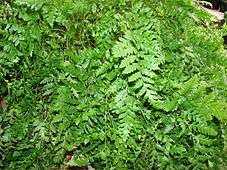Rumohra adiantiformis
| Rumohra adiantiformis | |
|---|---|
 | |
| Scientific classification | |
| Kingdom: | Plantae |
| Division: | Pteridophyta |
| Class: | Polypodiopsida/Pteridopsida (disputed) |
| Order: | Polypodiales |
| Family: | Dryopteridaceae |
| Genus: | Rumohra |
| Species: | R. adiantiformis |
| Binomial name | |
| Rumohra adiantiformis (G.Forst.) Ching | |
Rumohra adiantiformis, commonly called leatherleaf fern and leather fern,[1][2] leathery shieldfern,[3] iron fern,[4] 7-weeks-fern,[5] and climbing shield fern,[6] is a species of fern in the family Dryopteridaceae.
Distribution
The fern is native to South America, the Caribbean, southern Africa, the Western Indian Ocean islands, Papua New Guinea, and Australasia.[1]
Countries it is native to include such diverse places as Brazil and Colombia,[7] the Galápagos Islands,[8] the Greater Antilles in the Caribbean, Zimbabwe and South Africa[1] Australia, and New Zealand.
An example plant associations of Rumohra adiantiformis is found in the podocarp/broadleaf forests of Westland, New Zealand, with flora associates including Ascarina lucida, Pseudowintera colorata, Pseudopanax colensoi, Cyathea smithii and Blechnum discolor.[9]
Description
The fronds of Rumohra adiantiformis contain round sori (reproductive clusters) on the underside of the pinnae (leaflets) unlike many other ferns which have separate specialized reproductive fronds. Many of the sori have peltate indusia and have prominent scales on the stipes of the fronds. This species has a broad distribution; for example, Rumohra adiantiformis is found in the Old World as well as the New World,
Cultivation
The fern is cultivated as an ornamental plant. It is used as a groundcover and in floral arrangements.[2]
It is of economic importance in Brazil, where thousands of people generate their income by wild-harvesting and selling the fronds.[5]
References
- 1 2 3 U.S. National Plant Germplasm System; GRIN-Global Web v 1.9.7.1: Taxonomy profile of Rumohra adiantiformis
- 1 2 Gilman, E. F. Rumohra adiantiformis. Fact Sheet FPS-515. University of Florida Cooperative Extension, IFAS. 1999.
- ↑ Rumohra adiantiformis. Flora of Tasmania.
- ↑ Rumohra adiantiformis. USDA PLANTS.
- 1 2 De Souza, G. C., et al. (2006). An ethnobiological assessment of Rumohra adiantiformis (samambaia-preta) extractivism in Southern Brazil. Biodiversity & Conservation 15(8), 2737-46.
- ↑ Rumohra adiantiformis. Museum of New Zealand Te Papa Tongarewa, Wellington.
- ↑ Gonzalez Castiblanco, G. P. 2004. Factibilidad de exportacion de follaje de helecho de cuero (Rumohra adiantiformis) para ramos o adornos frescos. Pontificia Universidad Javeriana, Bogota, Colombia, Facultad de Ingenieria, 134 pages.
- ↑ Wiggins, I. L. Flora of the Galápagos Islands. Stanford University Press. 1971. 998 pages ISBN 0-8047-0732-4, ISBN 978-0-8047-0732-9
- ↑ Hogan, C. M. 2009. Crown Fern: Blechnum discolor Globaltwitcher.com, ed. N. Stromberg.
External links
| Wikimedia Commons has media related to Rumohra adiantiformis. |
